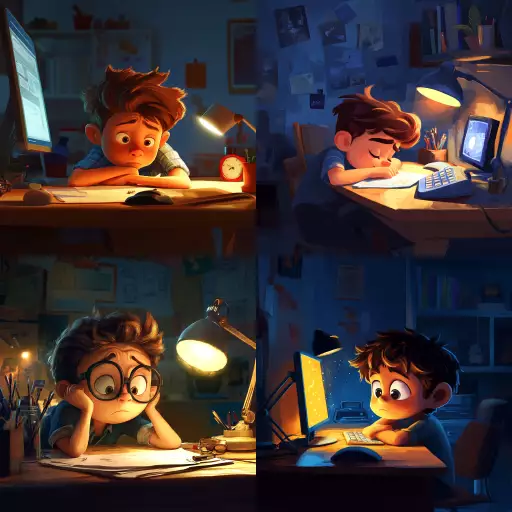Explore the Best AI Image Gallery

Beyond the Canvas: How AI-Generated Visual Content is Reshaping the Creative Industry
The realm of creativity has always been a space where imagination reigns supreme. However, the advent of artificial intelligence (AI) has introduced a new dimension to this landscape, blurring the lines between human and machine ingenuity. AI-generated visual content, in particular, is rapidly transforming the way we create, consume, and interact with art, design, and media.
From breathtakingly realistic images to mind-bending abstract art, AI algorithms are now capable of producing stunning visuals that rival, and sometimes even surpass, human creations. This has sparked both excitement and apprehension within the creative industry, as artists, designers, and consumers alike grapple with the implications of this technological revolution.
Unleashing Creative Potential: Applications of AI-Generated Visual Content
The applications of AI-generated visual content are vast and ever-expanding. Some key areas where this technology is making a significant impact include:
- Art and Design: AI algorithms can generate unique artwork in various styles, from classic oil paintings to modern abstract compositions. This opens up new possibilities for artists to explore unconventional concepts and push the boundaries of their creativity.
- Marketing and Advertising: Businesses are leveraging AI to create personalized marketing materials, dynamic advertisements, and captivating visual content that resonates with target audiences on a deeper level.
- Entertainment and Gaming: AI-generated visuals are being used to enhance the immersive experiences in video games, films, and virtual reality environments. This includes creating realistic characters, landscapes, and special effects.
- Education and Research: AI can be used to generate visualizations that help explain complex scientific concepts or historical events, making learning more engaging and accessible.
Navigating the Ethical Landscape
While the potential of AI-generated visual content is undeniable, it also raises important ethical considerations:
- Copyright and Ownership: Questions arise about who owns the copyright to AI-generated artwork – the developer of the algorithm, the user who provides the input, or the AI itself?
- Bias and Representation: AI algorithms are trained on massive datasets, which can contain inherent biases. This can result in AI-generated content that perpetuates stereotypes or lacks diversity.
- Job Displacement: There are concerns that AI-generated visual content could automate creative tasks, leading to job losses in the design and art industries.
Shaping the Future: Trends in AI-Generated Visual Content
The field of AI-generated visual content is rapidly evolving. Here are some key trends to watch:
- Increased Accessibility: AI tools will become more user-friendly and accessible to a wider range of individuals, empowering non-experts to create stunning visuals.
- Personalized Content Creation: AI will enable the creation of highly personalized content tailored to individual preferences and needs.
- Interactive and Immersive Experiences: AI-generated visuals will play an increasingly important role in creating interactive and immersive experiences in virtual reality, augmented reality, and other emerging technologies.
- Ethical Frameworks and Regulations: As the use of AI-generated visual content expands, there will be a growing need for ethical guidelines and regulations to address concerns about bias, copyright, and responsible use.
AI-generated visual content is undoubtedly transforming the creative landscape. While challenges remain, this technology holds immense potential for innovation, creativity, and pushing the boundaries of whats possible in the world of art, design, and media. By embracing ethical considerations and fostering collaboration between humans and AI, we can unlock the full power of this transformative force and shape a future where creativity knows no bounds.

![**Representation: A teenager smiling while thinking about a friendly dog, a comic-style thought bubble with a friendly dog inside. Graphic style: Line drawing, cartoon style, influenced by Franco-Belgian comics, thick black lines, simplified design, vector, black and white only, in the style of Keith Haring or the French comic strip "Alinéa". [IMPORTANT]: A single continuous line extending from one side of the image to the other, minimalist, strong outlines, line drawing, without lifting the hand, ultra-simplified, no shading, entirely white image, drawing created in the center of a sheet of paper. --ar 16:5** - <@627984126871470085> (fast)](https://images.ai-img.art/thumbnails/150/6fc850f638e3dee0c4b121acecad2c8419e02bdeac7f871d625f1003c1c3abe1.webp)







![**Representation: A dog acting as a private tutor to a child. The dog holds a ruler in its paw and stands at the blackboard to explain a dog diagram to the child. Graphic style: Line drawing, cartoon style, influenced by Franco-Belgian comics, thick black lines, simplified design, vector, black and white only, in the style of Keith Haring or the French comic strip "Alinéa". [IMPORTANT]: A single continuous line extending from one side of the image to the other, minimalist, strong outlines, line drawing, without lifting the hand, ultra-simplified, no shading, entirely white image, drawing created in the center of a sheet of paper. --ar 16:5** - Variations (Strong) by <@627984126871470085> (fast)](https://images.ai-img.art/thumbnails/150/f4e034998ccd869d8a061fd12017514fcd92210eb33d4222dc9b54716223f4dd.webp)
](https://images.ai-img.art/thumbnails/150/157712d76865d557120f9baf988de3d0525225295a2789c89bf2c4a5a96a03d1.webp)











](https://images.ai-img.art/thumbnails/150/51c93500396faff4e7fa8b42bc68033067b16b2230e3496e95c482a581ff0fe9.webp)
](https://images.ai-img.art/thumbnails/150/9d51c5e673b4f2068b7b01abc35425a06f173b76303adf9ad29ca14302c25b18.webp)


















![**Representation: A dog acting as a private tutor to a child. The dog holds a ruler in its paw and stands at the blackboard to explain a dog diagram to the child. Graphic style: Line drawing, cartoon style, influenced by Franco-Belgian comics, thick black lines, simplified design, vector, black and white only, in the style of Keith Haring or the French comic strip "Alinéa". [IMPORTANT]: A single continuous line extending from one side of the image to the other, minimalist, strong outlines, line drawing, without lifting the hand, ultra-simplified, no shading, entirely white image, drawing created in the center of a sheet of paper. --ar 16:5** - <@627984126871470085> (fast)](https://images.ai-img.art/thumbnails/150/7a854648a81e51241dcca8d24dd6e3bfcf07ad1df51baf401c9b729f4cf411fa.webp)

